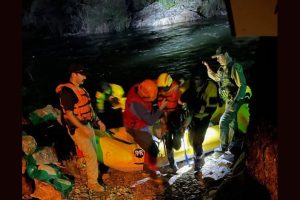West Point, CA – A man panning for gold along the banks of the North Fork of the Mokelumne River in the West Point area along the Amador/Calaveras County line is lucky to be alive.
On Monday around 5 p.m., the man was swept away by the river’s “substantial flow” due to the historic rain runoff and snow melt, according to Calaveras County Sheriff’s officials. Its Search and Rescue Team (SAR) was activated to assist the Amador County Sheriff’s Office Swiftwater Team and the Stanislaus County Sheriff’s Office Air Division in coordinating the rescue after an Amador Deputy spotted the man on the Calaveras side of the river about 4-5 miles downstream of his last known location.
The challenge for rescuers was that the man was approximately 85 feet up a steep, loose slope directly over the river, with no access to him from that side. A plan was devised to use the swift team’s river raft to cross the river with two Calaveras rescues inside. They would use ropes to ascend the cliff and then lower the man into the raft below. The man, who was “extremely cold,” was treated by medical personnel for non-life-threatening injuries.
Calaveras Sheriff’s officials remind the public that rivers and streams are experiencing abnormally high flow rates and are extremely dangerous. They shared, “Your lack of caution could cost you more than a cold night on the side of a cliff. It could cost you your life.”
Calaveras Sheriff’s officials offered these tips for recreating near waterways:
- Wear a properly fitted Personal Flotation Device (PFD) at all times when you are in or near the river. A life jacket can also provide some thermal protection against the onset of cold-water shock and keep you afloat until someone else can rescue you.
- Always swim within your own ability. Stay out of the deep or fast-moving water if you are not a strong swimmer.
- Carry a first aid kit and know how to use it. Learn or review medical aid responsibilities and learn CPR.
- Several bodies of water have varying topography, some with sharp drop-offs. Many unseen obstacles can be lurking below the water’s surface – this is especially the case during spring and early summer snowmelt. Rising water can make these obstacles even more treacherous. Enter the water feet first. Never dive headfirst into the water.
- If you become tired while trying to swim back to shore, try to calm yourself from fear to conserve energy and float on your back.
- Provide constant supervision for children or persons who do not swim well.
- Be prepared for extremes in weather, especially cold. Know about the dangers of hypothermia and how to deal with it. Know the early signs and symptoms of heat exhaustion and dehydration in hot weather.
- Cold water entering the ear canal can cause vertigo and disorientation. This may confuse swimmers, causing them to venture deeper into the water.
- Cold water also reduces body heat 25 to 30 times faster than air does at the same temperature and causes impairment that can lead to fatalities.





